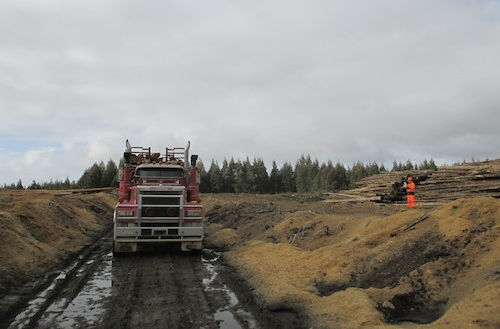Reducing moisture content in timber to save millions
Reducing moisture content in timber to save millions

Growers could save millions of dollars by furthering knowledge as to how timber dries while being stored, thanks to an FWPA-managed research project. Desktop planning tools and a smartphone app have been developed, supporting forest managers to optimise cost savings associated with infield drying of timber.
Green wood is made up of about 50 per cent water, meaning substantial transport cost savings can be achieved through infield log drying, allowing more wood fibre and less water to be transported.
With more than 25 million tonnes of predominantly green logs and chips transported in Australia each year, at a cost of more than $350 million, even relatively small moisture reductions of less than 10 per cent could result in annual transport cost savings of millions.
Researchers from the University of the Sunshine Coast’s Forest Industry Research Centre (FIRC) looked at drying forest biomass and timber infield, considering the impacts on product quality, storage costs, and machinery wear and tear, to develop systems that will help industry reduce transport costs.
The initial phase of the research found that in summer, during the first week of storage, drying rates exceeding one per cent moisture content per day were possible.
Professor Mark Brown, Director of the FIRC said a literature review conducted by the research team demonstrated the use of post-harvest forest biomass for domestic energy use and export is common overseas, but largely untapped in Australia due to high delivery costs.
“If biomass and logs for chips and other wood products can be dried infield, transport costs may be reduced, and biomass energy content will be increased,” Prof. Brown said.
While infield drying of chip logs and higher value logs can lead to deterioration in quality and additional machinery wear and tear, little was known about how substantial these costs were, and at what point moisture content became significant.
The FIRC project included infield drying trials of biomass, chip logs and higher-value wood products. The results were then used to create drying models and software tools, followed by operational trials conducted with industry collaborators.
“The predictive tools will enable forest growers to make informed decisions regarding infield storage of logs and biomass, so they can reduce moisture content to the point where returns from lower transport costs outweigh any losses from reduced quality, increased storage costs and increased machinery wear and tear,” Prof. Brown said.
Elsewhere, forestry management company Forico recognised that while reducing the moisture content and weight of timber enables a higher volume of wood to be transported at lower cost, their commercial arrangements meant timber was paid for specifically based on weight.
To ensure they purchased dried wood being sold at the same price as an identical volume of green wood, the company undertook its own research, which examined how logs might be measured and paid for by volume of actual wood, rather than total weight.
With operational solutions to manage their supply chain and commercial transaction based on timber volume, Forico and their contractors are now realising important efficiencies, including lower transport costs associated with the transportation of drier timber.
“This is a great example of an FWPA investment in research that has generated foundational information, which industry members are able to access and utilise for the benefit of their own research projects,” Prof. Brown concluded.
Source: Forest & Wood Products Australia

























